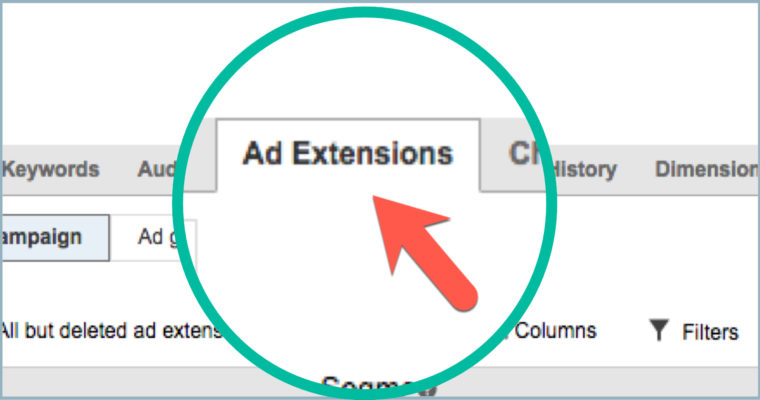
Not all ad extensions are created equal.
Whether it’s on Google AdWords or Bing Ads, ad extensions maximize your visibility in the search results.
Ad extensions also allow for additional or deeper messaging that doesn’t fit in the base ad copy.
Here are four PPC ad extensions you should be using today.
1. Structured Snippets
Structured Snippets are one of the easiest ad extensions to create because they have a predefined “header” for information and are not linking to the website. Each snippets extension has a “heading” such as:
- Amenities
- Brands
- Destinations
- Degree programs
- Courses
- Featured hotels
- Insurance coverage
- Neighborhoods
- Service catalogs
- Models
- Show
- Styles
- Types
After selecting the header, enter the values – such as “free WiFi” or “pool” for amenities. These extensions also tend to show frequently on both platforms.
Here’s an example of a Bing Ads set-up for a university degree program:

Both PPC platforms allow for scheduling of a start/end date and a custom schedule.
This feature would be ideal, for example, for a travel company that would like to promote a different set of offers, based on seasonality.
In AdWords, a structured snippet can be added to the account, campaign, or ad group level. Bing Ads can’t be set at the account level.
2. Affiliate Location Extensions
These AdWords extensions are really interesting because they allow companies who sell through retail outlets to promote nearby stores where their product can be purchased.
In the past, manufacturers would be limited to serving a reference page or locator page listing their resellers. Now, the ad can be shown with affiliate location extensions, showing locations by address or map with the ability to click for directions from mobile.
While this ad extension has a special cool factor, it needs more work. Some of the limitations include:
- Extensions can only be assigned at the account level. What if you manufacture different product lines sold at different retail stores?
- The list of available chains is limited to large well-known retail chains in the U.S. (e.g., Costco, Lowe’s, Macy’s, Walgreens) and in the UK (e.g., Apple, Iceland, Manor Pharmacy). You’re out of luck if you don’t distribute to a chain on the list. If you distribute to any independents or smaller chains, there’s no way to enter or upload a list of addresses.
- The overall customization and granularity is limited. For manufacturers with restrictions by product or product line, this extension isn’t especially helpful.
This is a good extension to watch as development continues with additional features. Bing Ads doesn’t offer a comparable ad extension at this time.
3. Price Extensions
AdWords released Price Extensions last year. These are a great alternative for advertisers that don’t have product feeds and can benefit from showcasing products and services with price points.
Price extensions are presented in the search results below the main ad text and can be useful in attracting greater attention to the ad as well as driving to deeper content on the advertiser’s website.
A minimum of three and up to eight items, or cards, can be added per price extension. A searcher can then scroll through and click on items individually to view.
Similar to the structured snippets, Google has predefined types of price extensions:
- Brands
- Events
- Locations
- Neighborhoods
- Product categories
- Product tiers
- Service categories
- Service tiers
- Services
Each card has a header and description of 25 characters each, appearing above and below the price.
The advertiser also has the opportunity to use a price qualifier. This is designed for products or services that don’t have one set price point, so “from”, “up to”, and “average”. For example: “Monday Dinner Specials from $25”.

These extensions can be added to the account, campaign, or ad group level. Adding to the ad group level is a great place for more detailed items to be tailored to a subgroup. For example: “vacations in Europe” vs “French vacations”.
These ad extensions can also be scheduled for a start and end date, along with custom hourly scheduling.
Google has created a way to bulk upload price extensions into the account should manual entry be too time-consuming. In the ad extensions tab, under the price extensions view, advertisers can download a spreadsheet template under the edit menu.
Bing Ads doesn’t offer a comparable ad extension at this time.
4. Call Extensions
Call extensions serve a phone number with the ads. These aren’t new, but are more important than ever as mobile has become the primary device for many searchers.
Advertisers who have avoided call extensions in the past should take a second look. Besides connecting searchers directly with the business by phone call, using the PPC platform’s forwarding numbers will show some call information, call conversions, and valuable search data on how people are finding the phone number.
A phone call can be counted as a conversion, defined by the number of seconds a caller is on the phone call. The number of seconds should be defined based on each business’ unique phone behavior for closing callers.
If phone call lengths are below this threshold too frequently, or many calls are missed, it’s a good time to review a few simple optimization ideas:
- Are too many “wrong” numbers coming through? This could be due to the ad being triggered by a different business name based on keywords. Check the search queries and ask phone reps what they have been hearing from callers. These keywords can be used as negative keywords.
- Too many missed calls? Ensure the ad is scheduled during business hours only when someone is available to answer that call. That could mean not running ads during the lunch hour.
- Calls from areas not serviced by the business? This is usually just a case of adjusting geotargeting to be more accurate. Although, it could present an opportunity to learn more about these callers and the current market.
Final Thoughts
Ad extensions can be critical to rise above the competition in search results with more visibility and strategic messaging. It’s important to review ad extensions and audit them on a scheduled basis (try quarterly) to ensure you are learning about new opportunities available and revisiting old ones.
Image Credits
Featured Image: Lisa Raehsler
In-post Images: Screenshots by Lisa Raehsler. Taken May 2017.
Article source: https://www.searchenginejournal.com/ppc-ad-extensions/198359/
